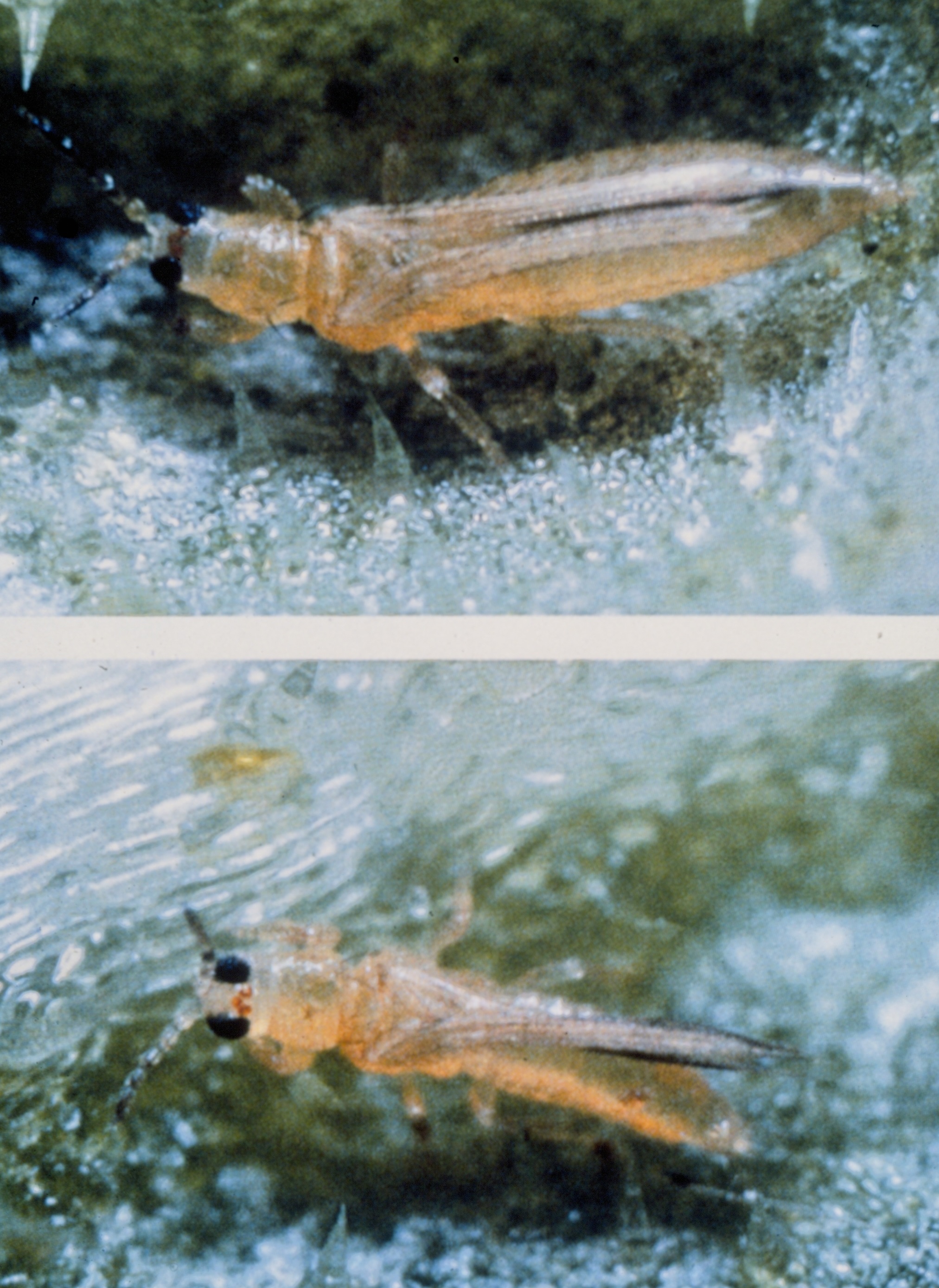|
Thripidae
The Thripidae are the most speciose family of thrips, with over 290 genera representing just over two thousand species. They can be distinguished from other thrips by a saw-like ovipositor curving downwards, narrow wings with two veins, and antennae of six to ten antennomeres with stiletto-like forked sense cones on antennal segments III and IV. They are considered to be among the more derived of thrips, having evolved many traits key to specializing as cryptophilous phytovores, living in the narrow spaces at the bases of leaves and within flowers. Several species are economically significant pests, some of them invasive. Almost all of them are typical thrips which belong in the largest subfamily, the Thripinae. Systematics Many of the divisions within the Thripidae are not based on common ancestry, but are instead based on common environment and morphological homoplasy, and these distinctions tend to be irrelevant to true phylogenetic relationships. As a result, many speci ... [...More Info...] [...Related Items...] OR: [Wikipedia] [Google] [Baidu] |
Thrips
Thrips (Order (biology) , order Thysanoptera) are minute (mostly long or less), slender insects with fringed wings and unique asymmetrical mouthparts. Entomologists have species description , described approximately 7,700 species. They fly only weakly and their feathery wings are unsuitable for conventional flight; instead, thrips exploit an unusual mechanism, #Flight , clap and fling, to create lift using an unsteady circulation pattern with transient vortices near the wings. Thrips are a functionally diverse group; many of the known species are fungivorous. A small proportion of the species are serious Pest (organism) , pests of commercially important crops. Some of these serve as Disease vector , vectors for over 20 viruses that cause plant disease, especially the Tospoviruses. Many flower-dwelling species bring benefits as pollinators, with some predatory thrips feeding on small insects or mites. In the right conditions, such as in greenhouses, invasive species can expone ... [...More Info...] [...Related Items...] OR: [Wikipedia] [Google] [Baidu] |
Panchaetothripinae
Panchaetothripinae is a subfamily of thrips in the family Thripidae, first described in 1912 by Richard Siddoway Bagnall Richard Siddoway Bagnall (14 July 1884 - 19 January 1962) was an English entomologist. Bagnall specialised in Thysanoptera and published several important works on the higher classification of this insect order throughout the world, describing m .... There are about 11 genera and more than 50 described species in Panchaetothripinae. Genera These 11 genera belong to the subfamily Panchaetothripinae: * '' Anisopilothrips'' Stannard & Mitri, 1962 * '' Caliothrips'' Daniel, 1904 * '' Dinurothrips'' Hood, 1913 * '' Elixothrips'' Stannard & Mitri, 1962 * '' Heliothrips'' Haliday, 1836 * '' Hercinothrips'' Bagnall, 1932 * '' Hoodothrips'' Bondar, 1931 * '' Monilothrips'' Moulton, 1929 * '' Parthenothrips'' Uzel, 1895 * '' Retithrips'' Marchal, 1910 * '' Selenothrips'' Karny, 1911 References Further reading * * * * * * * External links Thripidae ... [...More Info...] [...Related Items...] OR: [Wikipedia] [Google] [Baidu] |
Thripinae
The Thripinae are a subfamily of thrips, insects of the order Thysanoptera. The Thripinae belong to the common thrips family Thripidae and include around 1,400 species in 150 genera. A 2012 molecular phylogeny found that the Thripinae was paraphyletic; further work will be needed to clarify the relationships within the group. Notable members – some of them economically significant pests – are for example '' Anaphothrips susanensis'', '' Megalurothrips distalis'', '' Sciothrips caramomi'', ''Scirtothrips dorsalis'' (chili thrips), '' Sorghothrips jonnaphilus'', '' T. hawaiiensis'', '' T. palmi'' (melon thrips) and '' T. tabaci'' (onion thrips). The subfamily includes many pests, some of them invasive species. The chili thrips, ''Scirtothrips dorsalis'', is an Asian pest on many crops, including chili peppers, roses, strawberry, tea, ground nuts, and castor bean. The western flower thrips, ''Frankliniella occidentalis'', has recently expanded its range from western North A ... [...More Info...] [...Related Items...] OR: [Wikipedia] [Google] [Baidu] |
Taeniothrips Inconsequens
''Taeniothrips'' is a genus of insects belonging to the family Thripidae. The genus has almost cosmopolitan distribution In biogeography, a cosmopolitan distribution is the range of a taxon that extends across most or all of the surface of the Earth, in appropriate habitats; most cosmopolitan species are known to be highly adaptable to a range of climatic and en .... Species: * '' Taeniothrips amomi'' Priesner, 1938 * '' Taeniothrips angustiglandus'' Han & Cui, 1992 References {{Authority control Thripidae Thrips genera ... [...More Info...] [...Related Items...] OR: [Wikipedia] [Google] [Baidu] |
Pear Thrips
Pears are fruits produced and consumed around the world, growing on a tree and harvested in late summer into mid-autumn. The pear tree and shrub are a species of genus ''Pyrus'' , in the family Rosaceae, bearing the pomaceous fruit of the same name. Several species of pears are valued for their edible fruit and juices, while others are cultivated as trees. The tree is medium-sized and native to coastal and mildly temperate regions of Europe, North Africa, and Asia. Pear wood is one of the preferred materials in the manufacture of high-quality woodwind instruments and furniture. About 3,000 known varieties of pears are grown worldwide, which vary in both shape and taste. The fruit is consumed fresh, canned, as juice, dried, or fermented as perry. Etymology The word ''pear'' is probably from Germanic ''pera'' as a loanword of Vulgar Latin ''pira'', the plural of ''pirum'', akin to Greek ''apios'' (from Mycenaean ''ápisos''), of Semitic origin (''pirâ''), meaning "fruit" ... [...More Info...] [...Related Items...] OR: [Wikipedia] [Google] [Baidu] |

